QuestionQUESTION: Hello Pat, I've since wanted to care for more skinny pigs (SP)since I just LOVE these guys and own some. I've studied on 'some' genetics but not a lot so far and I guess everyone is a novice in the beginning.
I realize that because I don't have any female skinnies, I would have to breed a regular GP to one of our male skinny pigs (all healthy and wonderful) to get gene carriers. From there, hopefully a female or 2 will arrive so one day I'd be able to breed 'her' to another one of our male SP's. I would be delighted if that litter then produced some skinny pigs.
Again, we have the room and of course will definitely keep any and all babies but what I need to know is: if I have a female that is 1/2 Peruvian, 1/2 short hair, will she be a good candidate for the 1st mating? The other thing is, I also have a couple of young females which are 1/2 Abyssinian, 1/2 short hair, would one of them be better? I only want to try 1 female out of any of them.
I was told that short haired GP's would make the best gene carriers but also told not to use any with Peruvian in the ancestry. It sounds logical with all that hair even tho' the female 'baby' doesn't show it, she's now 5 mo, 840g.
The Abyssinians I was speaking of, one has the rosettes and crazy hair, the other 'looks' short haired but I assume this means nothing. Will either of these 1/2 breeds inhibit trying for skinny pig genes?
If not, once the skinny & 1/2 breed have babies, could I use one of the females (if any) to breed to another one of my male SPs? Would I then get some skinnies? I don't want numerous litters obviously, just 2 perhaps before actual skinny pigs, even if there's only a couple in the last litter.
I've tried to adopt skinnies as well as buying them, but I've had two die after only having them for a month or so, and since these are one of 2 favourite breeds of mine, I'd rather do it myself, so to speak, so I'm assured of the care, health of parents, etc. Plus, they are so expensive even from adoptees that I'm tired of putting money in their pockets as well as the petstore. I'm not looking to sell them.
Thanks Pat for everything.
Paula
ANSWER: Unfortunately Paula, breeding the way you describe will not bring you any Skinny Pigs. They originated from a mutant gene that began with Teddies, so crossing Aby's, Peruvians, Americans would do nothing. You would most likely end up with a mish mash of cross breeds, so why risk any of your sows for a failed attempt?
Have you tried searching the net for Skinny breeders? I know there are some in Canada and in the New York areas. Your best bet would be to contact someone that has Skinnies and get their advice. Skinny carriers are generally Teddies that have that recessive gene. Same goes with Baldwins which are the completely hairless pigs that originated from White Cresteds.
The people who are breeding for Baldwins MUST have a WC carrier in order to bring out that recessive gene that will produce a Baldwin. Same goes with the Skinny Pigs. What you would have to do is obtain a Teddy, breed to a Skinny and the babies will have one gene from each parent. If you have a Skinny boar that sires that litter, you breed back one of the baby sows to him. You would then have babies with a stronger gene base for SP's.
Creating a new breed or variety means a lot of selective inbreeding and linebreeding to get the desired traits. It's a risky and time consuming effort and generally takes two to three years to begin reaching your goal.
Your best bet is to get a Skinny trio if you can. Even if one of the babies the litter is a coated pig it is a carrier. Crossing that with another Skinny may not give you an entire litter of SP's, but then it might. It's a gamble.
The same thing holds true with the Baldwins, except that when they are born they all have hair and those who will be Baldwins start losing it at about a week or ten days. In other words breeding hairless to hairless is not a guarantee of a hairless litter. With a Skinny litter what you see is what you get. They are born hairless, except for the little tufts of hair on the nose, feet and ears.
One of our new experts, Cindy Hunt, has Skinny Pigs and uses them for therapy pigs. She might be able to offer some help. I don't know if she breeds herself but you can certainly ask her opinion.
You also need to be aware that sometimes what you get is an overdose of criticism from folks who are not breeding for show animals. They tear you apart and shame you for even thinking of doing this and try to make you feel like a monster because you wish to breed, so learn how to take that with a grain of salt if you are determined to reach your goal.
Another option is to go online and see if there is a breeder closer to you that would be willing to share some breeding tips. Please remember though that breeding is a risky and tricky thing. The losses are higher than in most species. It can be a heartbreaker, so you have to be willing to accept that and risk your sows in that attempt.
I don't how much this really helps you but I will keep my fingers crossed that you are successful.
---------- FOLLOW-UP ----------
QUESTION: Hello Pat and thanks for answering. As usual your answer is very thorough and informative if not somewhat disheartening LOL.
I have written to C.H. on this website, but it had to be resent after 3 days and I haven't heard anything still.
Anyway, this is 1 website I've looked up http://raysskinnyguinea.weebly.com/what-is-a-carrier.html
I hope it comes up for you if you wish to check it. If this link doesn't come up, it's at least under Rays Skinny Pigs. It is where I've found the info. as far as breeding to get a 'carrier'. Then it seemed like you bred that carrier to a true skinny pig for a litter of 50% skinnies I believe.
I'm still studying on it but this sounded so easy, where I'd only have to have 2 or 3 litters to get a few skinnies (again, keeping the rest as well) and I'm aware of the risks, as even with a couple of my sows, we've lost a few babies from a couple of different litters.
Of course I will not even contemplate it if it sounds like I'd have to get into years of breeding full tilt.
If you check out this part of the website I gave, perhaps you'll see what I mean under the headline What Is A Carrier. He gives a list of breeding skinny to skinny, skinny to normal, etc. etc. Perhaps I've missed something?
Thanks again Pat!
Paula
AnswerI was able to bring up the site. I understand what they are saying about the percentages, although it doesn't always work out that way, but that's another chapter.
As I said the original Skinnies came from Teddies which is why they have the curly hair at the nose,ears and feet. Bringing in an American is going to "spoil the broth" so to speak. I still believe that using a Teddy as your starting point to breed to the Skinny carrier will more quickly give you what you're looking for.
When you're working on a new variety or a breed you still must work with genetic compatibility. Not all breeds are compatible with one another. The best example of that is the English Rex which from appearance is simply a Teddy from the UK. Breeding a Teddy to a Rex will give you (are you ready) American appearing babies with short smooth hair. That's because of genetic incompatibility and it cancels one another out.
Same is true of Texels vs Alpacas (again from the UK). Texels were developed in Europe by crossing and re-crossing the Rex and the Sheltie (which looks like our Silkies). In the 1980's when Texels first appeared American breeders thought they could avoid having to ship these Texels to the US and could 'make their own' by crossing Teddies and Silkies. What they got were short haired smooth coated pigs, i.e. Americans.
Again it was genetic incompatibility that cancelled out the genes and taking them back to the original cavia porcellus, aka guinea pigs. Whenever you cross genetically incompatible breeds you end up back at the starting line--short haired, smooth coated pigs.
I suppose it's the same concept as mixing paint. When we mix two of the primary colors such as red and yellow we get orange. Mix yellow and blue and we get green. Mix all three and you get a dark shade of no color. So not everything is as it seems by just appearance.
I hope I'm not confusing you more. Genetics is a difficult concept to understand and I don't make any claims about being an expert at it. But I do know the basics. Without meaning to make this longer than it already is I want to tell you about a genetic "screw up" on my part with my American Himalayans.
I have been working on Himis for 12 years. I finally have achieved that coveted bunny face look on my pigs that is so prized on the show table. But in doing so I began to lose the dark points that make a Himalayan what it is.
My first Himi babies were born from a black to black breeding of Americans that I bought from another breeder because I wanted to breed blacks. According to the genetic rules when you cross a true black to a true black you get blacks. Seems simple enough.
When the litter was born there were too completely white babies. One male and one female. Within days it was apparent that they were beginning to get Himi points. The ears darken first, then the nose then the bottoms of the feet and lastly the tops of the feet.
In researching their pedigrees both parents went back four generations to a Himi/black crossing. The recessive genes were expressed by breeding the two blacks I had. In crossing and selectively line breeding the parents and the pups within two years I got nothing but Himis from crossing Himi to Himi. Now my Himalayans throw nothing but Himis when crossed with the same.
Enter last summer: I had a handful of black babies born from my Golden Solids. I kept two black baby boars from two different litters and when they were old enough I bred them each to two Himi sows. I had four litters of what is called Sepia pups. Chocolate in appearance but had black pads on their feet. They're neither chocolate nor black. They are a batch of "mixed paint" that canceled out the colors of each of the parents.
They can't be shown and are only good for pets, so I gave them to a friend who has a certificate of development to work on a color called Sable.
He was able to use the genes of these mixed up colors to cross with his Himalayans to develop a new color in cavies called Sable. That color is present in rabbits but has not been developed in guinea pigs yet. It will take about five or six years to be able to 'set the genes' of a new color so that it is consistently reproduced in every litter. Then it can be presented for acceptance by ARBA here in the US. It's a long and tedious effort.
The problem was that neither of my blacks had any Himalayan genes, so they were not compatible with the genetic makeup of my Himis. I risked four sows on a whim and it backfired.
Last year I obtained a Himalayan boar from the UK that has the awesome black points we strive for. In the UK they don't have the beautiful type of the American bred pigs, but their color is superb. What I'm getting so far are the pups I've hoped for. Beautiful type AND great color.
The morale of the story is this: don't risk your sows or waste your time trying to make something that will not be successful. If you want really good Skinny Pigs do it the right way. Stick with the Teddy/Skinny crossings and don't waste good pigs on bad breedings.
The risk is always there that you may lose your sows, so make sure you're taking that risk for the right reason. Do it right or don't do it at all.
Whew, that was windy wasn't it??

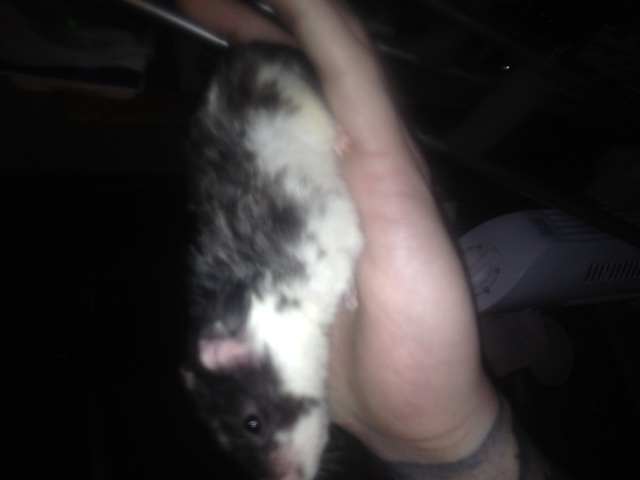 My hampster Mia plz Im begging help her
Question
Mia her arm under bell
My baby girl ham
My hampster Mia plz Im begging help her
Question
Mia her arm under bell
My baby girl ham
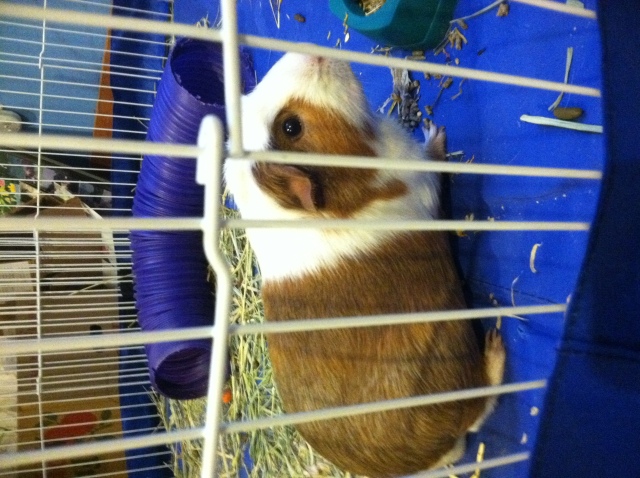 How to get a timid guinea pig active?
Question
Henry
Hello there!
I have a few questio
How to get a timid guinea pig active?
Question
Henry
Hello there!
I have a few questio
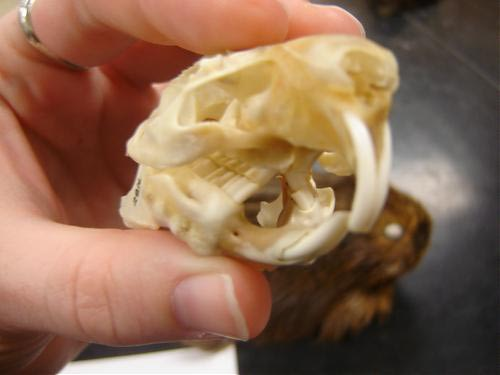 Malocclusion
QuestionQUESTION: My guinea pig has stopped eating and
Malocclusion
QuestionQUESTION: My guinea pig has stopped eating and
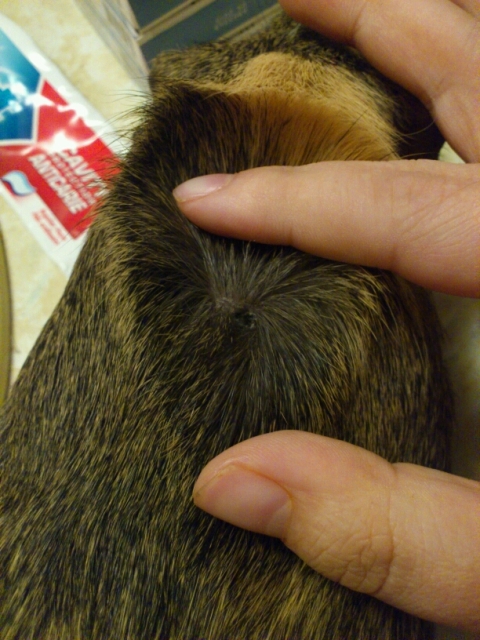 Guinea pig lump on back and open sore
QuestionQUESTION: I have 2 guinea pigs, no idea on the
Guinea pig lump on back and open sore
QuestionQUESTION: I have 2 guinea pigs, no idea on the
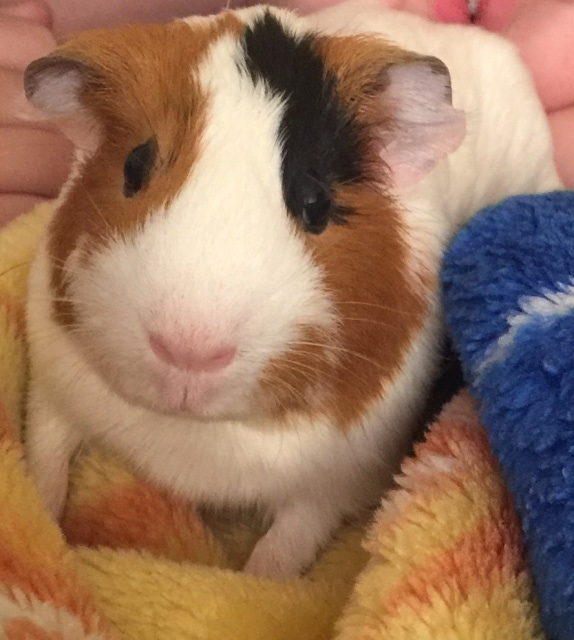 Guinea Pigs Age and Shedding and Bitting
Question
Molly Rosie
Hello I have 2 Sows p
Guinea Pigs Age and Shedding and Bitting
Question
Molly Rosie
Hello I have 2 Sows p